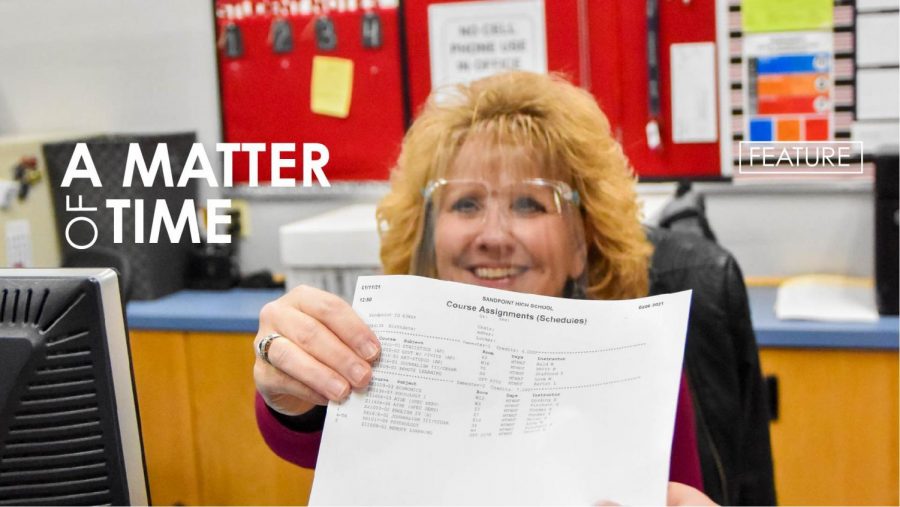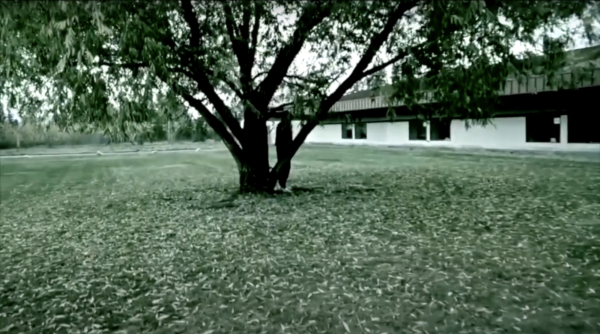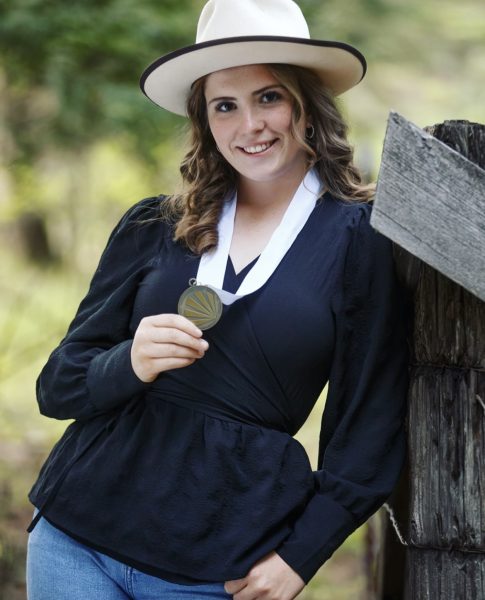A Matter of Time
The effectiveness of the emergency response schedule is weighed to decide what structure next school year will have.
As a freshman, you have transitioned to high school after tackling distance learning for the final months of middle school. You wonder if you will have to jump through more hoops with the possibility of having to adjust a new schedule next school year.
As a senior, you got comfortable with the routine you established over the last 3 years. Your expectations for this year turned upside down and your last year of high school becomes the experiment of an emergency response.
As a parent, you saw your kids abruptly adjust to distance learning and then dive into a new schedule. You want to see them less stressed and improve in their studies. Most importantly, you want them to have as normal of a High School experience as possible.
As a teacher, your agenda might have had to be adjusted to accommodate for shorter class periods. The pace of the curriculum in your classes has changed, but you are glad you get to see your students every day while you also have to account for students that you do not get to see face to face anymore.
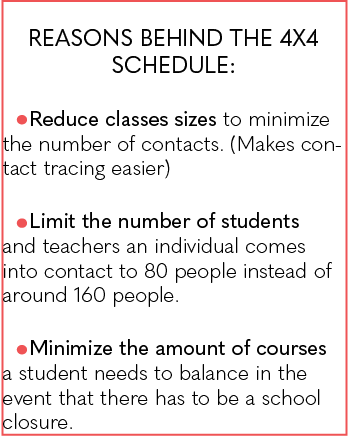
No matter what perspective you hold on the changes that have been made this year, you want to see decisions made that will benefit students who were thrown into unexpected circumstances. This school year, the 4×4 schedule was implemented at Sandpoint High School as an emergency response to the Coronavirus. Questions of whether or not this schedule has been effective and will continue to be used are on everyone’s minds.
From the administrative point of view, there are many factors that have to be considered before making an important decision about the trajectory of the next school year. They still have questions: Will we be post-COVID by next year? Will we have the same flexibility of blended learning? What type of schedule is best for students learning? Pleasing the majority of people is always a challenge, but Principal David Miles is determined to collect as much information as possible to make the best decision.
Planning for next year has started earlier so every school in the district can present a plan of what they think would be best for student learning next year. From there, the district will tweak their final plan to align with the requirements set in place by the State Board of Education who also must approve any hybrid classes that incorporate blended learning. 990 hours of instructional time and 60 hours of seat time for each course also have to be accounted for the SHS to be an accredited school.
This is the first time in over a decade that a radical change has been made to the scheduling system. SHS was originally on a 6 period day schedule. Back then, much debate and research went into choosing a block schedule over a 4×4 schedule.
Though this schedule has been successful, there are still valid concerns. The 4×4 schedule is not ideal for AP classes and some electives. If this schedule were to continue next year, there would be large gaps between classes that are meant to build off each other. For example, a student might go a full calendar year between taking math or foreign language class.
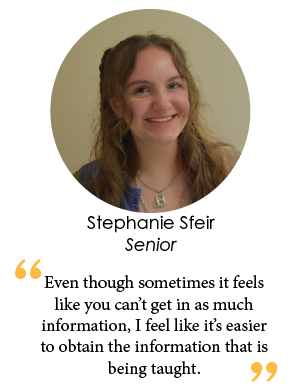
However, these same classes requested having their students meet every day for continuity. “You need that continuity and that daily practice in order for students to really be as successful as they can possibly be,” Miles said. This goes to show that creating a balance in the schedule is a real challenge.
Miles reached out to other schools in the country that have a 4×4 schedule as a long-standing plan rather than an emergency plan. “Really we’re just gathering input, getting data, and trying to get information to make the best decision at this point in time,” he said.
As a statistics teacher, Wendy Auld wants to see data collected on students’ retention and test scores, before a decision is made only based on how well people liked the schedule this year. “You shouldn’t make big decisions based on people’s education based on a gut feeling. You should make it based on data” she said.
A positive aspect of the schedule that Auld observed was “Kids had much better retention day today and so I had higher grades in my classes,” she said. However, Auld wonders if students will be able to retain what they have learned in the first semester when the day of their AP test comes.
Senior Stephanie Sfeir also sees the struggle with how this schedule affects AP classes. “For 1st term classes, It’s hard because you don’t have that teacher help towards the end of the year closer to the test, but then for the classes that are the second term, you don’t have enough time to learn all this stuff,” she explained.
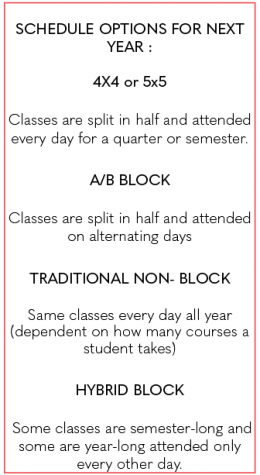
English Teacher Sarah Miles pointed out that the current schedule is helpful for preparing her students in Dual Credit courses since college courses work on a semester system like the 4×4 schedule has been exhibiting. Dual Credit classes
The biggest changes teachers have had to make is adjusting their curriculum and pacing of their courses to account for the shorter, daily class periods. Sarah Miles was skeptical of transitioning to the 4×4 schedule at the beginning of the year but was soon pleasantly surprised at how well it was working. She loves getting to see her students every day. “From my viewpoint, in my room, all I’ve really seen are the advantages of it,” she said.
Art teacher Ezra Stafford also enjoys seeing his students daily, but he wishes that they had more time in class. “Students need time to process and work through the period,” he said.
In his AP Studio Art class, projects were traditionally completed every 2-3 weeks. However, this year, the students have almost weekly deadlines and will have to finish the rest of their AP Art portfolio at home without the time for working on it structured into the school day. This is an example of how the 4×4 schedule has affected year-long classes.
Stafford thinks that a hybrid schedule that allows students to still have only four classes at a time yet gives them the option to take a course over a whole school year rather than half the year could be beneficial for the classes that need constant practice.
Department chairs and administration have started discussing what next year might look like, but they are mainly in the data and input collecting phase to weigh if it is practical to implement the same aspects of the schedule next year.
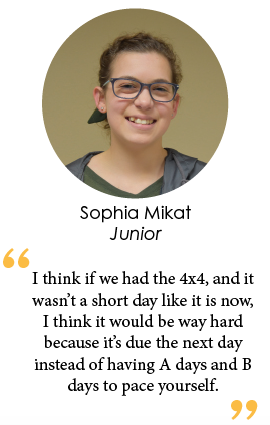
Since the school day has been shortened in response to COVID-19 recommendations, the bell schedule is also a factor to consider when planning next year’s structure. It could be a hard adjustment if the 4×4 schedule were in place along with 90 minute class periods.
“In any system that we end up choosing, I think we’ve all agreed that probably more training for our staff is needed just in general.” David Miles said. Teachers will have to rebalance their curriculum to maintain student engagement. There is the possibility of seeing an increase in disciplinary issues due to students’ fleeting attention spans over the extended class times.
David Miles believes that science supports learning material in shorter segments day to day is more beneficial for retention. Taking all these things into consideration and finding a balance is easier said than done.
Lake Ponderay School District Superintendent Tom Albertson said that everyone is trying to figure out how to incorporate the positive aspects of the 4×4 schedule into a somewhat regular schedule. However, finding a perfect balance among all the contributing factors is easier said than done. “To me it’s just going to take a little more brainpower, a little more creativity, a little more problem solving to work through it,” Albertson said.

What weird sound do you love?
I love the sound of a crackling fire. It reminds me of summer campfires and cozy winter nights at the same time.
What...

